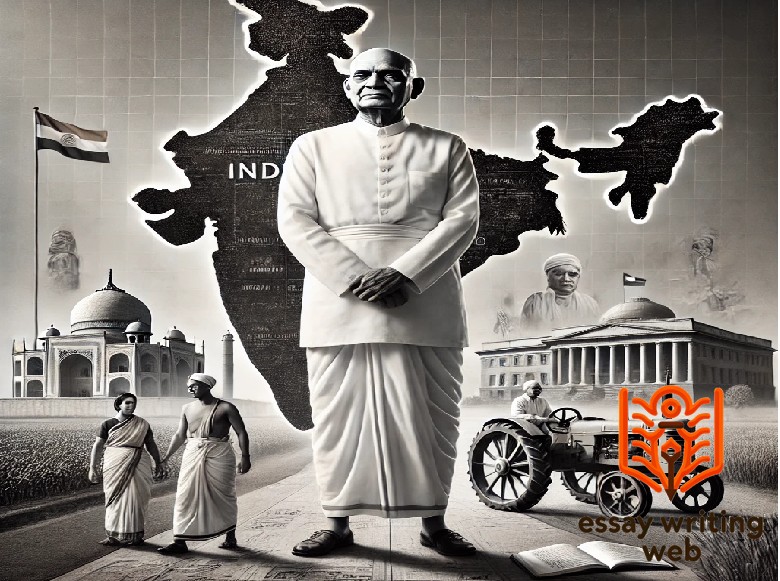 Essay Writing Web
Essay Writing Web
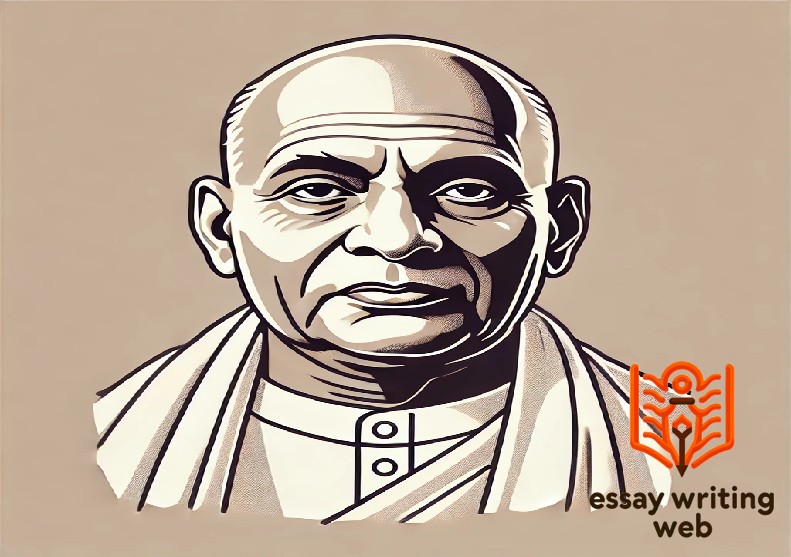
 31-08-2024
31-08-2024
 www.essaywritingweb.com
www.essaywritingweb.com
Sardar Vallabhbhai Patel, often referred to as the "Iron Man of India," was one of the most prominent leaders in the Indian independence movement and played a crucial role in the formation of the Republic of India. Born on October 31, 1875, in Nadiad, Gujarat, Patel was deeply influenced by the rural and traditional values of his upbringing, which later shaped his strong sense of justice and integrity.
Patel’s early life was marked by his determination and hard work. He pursued his education in law, eventually becoming a successful barrister. His legal acumen earned him respect and recognition, but it was his involvement in the freedom struggle that brought him to the forefront of Indian politics. Inspired by Mahatma Gandhi, Patel joined the Indian National Congress soon became one of its key leaders.
One of Patel’s most significant contributions was leadership during the Bardoli Satyagraha in 1928. This movement, which protested against unjust taxation policies imposed by the British, was a turning point in Patel’s political career and earned him the title "Sardar," meaning leader or chief. His success in this movement highlighted his leadership qualities and ability to mobilize the masses for a cause.
After India gained independence in 1947, Patel took on the monumental task of unifying over 560 princely states into the newly formed Union of India. His diplomatic skills, coupled with a firm hand when needed, ensured the integration of these states, preventing potential fragmentation of the country. This achievement was a testament to his vision and commitment to a united India.
Vallabhbhai Patel’s legacy extends beyond his political achievements. He was a staunch advocate of civil services, believing in the importance of a strong administrative framework for a stable nation. His efforts led to the establishment of the Indian Administrative Service (IAS), which remains a vital pillar of the Indian government today.
In recognition of his contributions, Patel is often celebrated as a national hero. The Statue of Unity, the world’s tallest statue, was erected in his honor in Gujarat, symbolizing his enduring legacy and the unification of India. Sardar Vallabhbhai Patel’s life, work continue to inspire generations, reminding us of the values of unity, integrity, and unwavering commitment to the nation.
Sardar Vallabhbhai Patel, a towering figure in India's struggle for independence and the unification of the country, was born on October 31, 1875, in the small village of Nadiad, located in the Kheda district of Gujarat. His birth into a humble and deeply rooted family laid the foundation for the values of perseverance, simplicity, and determination that would define his life and work.
Vallabhbhai was born into a family of Patidars, a community known for its agrarian lifestyle and strong sense of social and economic responsibility. His father, Jhaverbhai Patel, was a simple farmer with a deep sense of duty toward his land and community. Despite his modest means, Jhaverbhai was known for his honesty, hard work, and unwavering commitment to his principles. Vallabhbhai’s mother, Ladbai Patel, was a devout and religious woman who played a significant role in instilling moral values and a sense of discipline in her children. She was known for her wisdom and resilience, qualities that Vallabhbhai inherited and later demonstrated throughout his life.
The family was part of a close-knit community that upheld traditional values while also being open to the winds of change that were sweeping through India during the late 19th century. Vallabhbhai was the fourth of six children, growing up in an environment that valued education, though access to formal schooling was limited. The Patels were a large family, and like many others in rural India, they had to make do with limited resources. However, the strength of their familial bonds and a strong sense of duty toward each other created a nurturing environment for the young Vallabhbhai.
Despite the lack of abundant material wealth, Vallabhbhai’s parents were determined to provide their children with the best possible upbringing. They instilled in him the importance of hard work, honesty, and a sense of justice, all of which played crucial roles in shaping his character. The values learned during his early years in Nadiad stayed with Patel throughout his life, guiding him in his personal and professional endeavors.
As a child, Vallabhbhai showed remarkable resolve and independence. He was known for his quiet demeanor but possessed a strong will that was evident even at a young age. These traits, combined with the teachings of his parents, helped him navigate the challenges of his early life and later prepared him for the significant role he would play in India's history.
In conclusion, Sardar Vallabhbhai Patel's birth and family background provided him with a solid foundation of values and principles. Born into a modest yet principled family, he grew up with a deep understanding of the importance of integrity, hard work, and dedication—qualities that would later define his leadership in the Indian independence movement and his efforts to unify the nation.
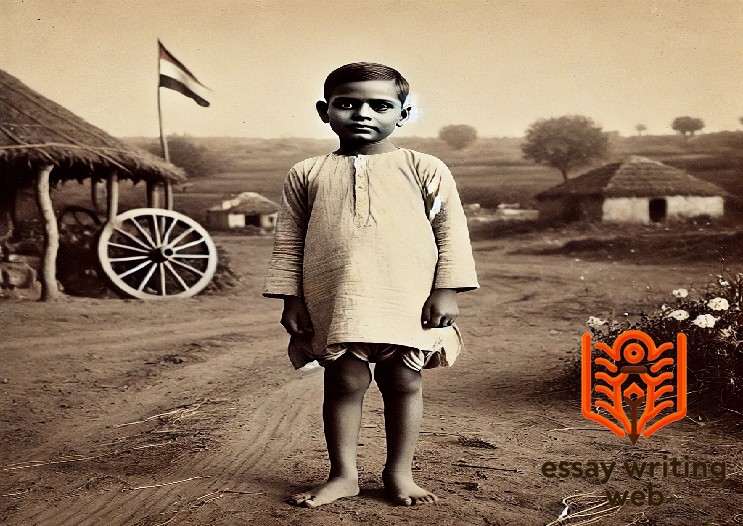
Sardar Vallabhbhai Patel, one of India’s most revered leaders, was not only a freedom fighter but also a distinguished lawyer whose early career laid the groundwork for his later political achievements. His journey from a modest educational background to becoming a successful barrister is a testament to his determination, intelligence, and hard work.
Born in Nadiad, Gujarat, in 1875, Vallabhbhai Patel’s early education was marked by the challenges typical of rural India at the time. He attended primary school in his village, where educational resources were limited, but his keen intellect and dedication to learning soon became evident. Vallabhbhai was a diligent student and despite the modest means of his family, he was determined to pursue further education.
Patel's desire for education led him to enroll in a secondary school in Petlad, and later in Nadiad, where he continued to excel academically. However, his educational journey was not a straightforward one. At a time when higher education was a privilege reserved for the few, Vallabhbhai had to overcome significant obstacles, including financial constraints and the responsibilities that came with being a member of a large family. Nevertheless, his perseverance paid off, and he completed his matriculation in 1897, a significant achievement for someone from his background.
Determined to continue his studies, Vallabhbhai decided to pursue law, a profession that was both respected and offered opportunities for social mobility. However, rather than taking the conventional route of immediately joining a law college, Patel chose to study independently. He borrowed books, studied on his own, and passed the district pleader’s examination, which allowed him to begin practicing law in the local courts.
His early career as a lawyer began in Godhra, where he quickly made a name for himself through his sharp legal mind and his commitment to justice. Patel’s reputation as a lawyer grew, and he soon became known for his ability to argue cases with clarity and precision. His success in the courtroom was matched by his ethical approach to the profession; he was known to take on cases that aligned with his principles, often helping those who could not afford legal representation.
Patel’s ambitions, however, extended beyond the local courts of Gujarat. Recognizing the importance of formal education and a broader perspective, he resolved to study law in England, a path that would not only enhance his legal career but also prepare him for the larger role he was destined to play in India’s freedom struggle. In 1910, at the age of 35, Patel sailed to London, where he enrolled at the Middle Temple, one of the four Inns of Court. Despite being older than most of his facing the challenges and classmates of adapting to a new environment, Patel excelled in his studies. He completed the 36-month course in just 30 months, graduating with flying colors in 1913.
Upon his return to India, Patel resumed his legal practice in Ahmedabad. His reputation as a barrister was further solidified as he took on more complex cases, often against the British government, showcasing not only his legal expertise but also his growing awareness of the political injustices faced by Indians under colonial rule. His success in the legal field brought him financial stability and respect, but more importantly, it gave him a platform from which he could begin his political journey.
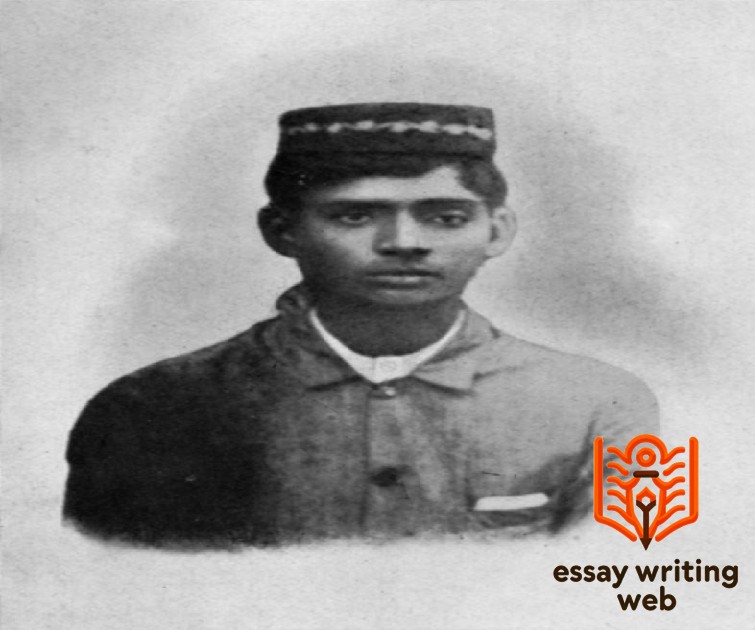
Sardar Vallabhbhai Patel, often hailed as the "Iron Man of India," was a pivotal figure in the Indian independence movement the subsequent unification of the country. A key aspect of his life and leadership was the profound influence that Mahatma Gandhi had on him. Gandhi's philosophy, vision, and methods of nonviolent resistance significantly shaped Patel's approach to India's freedom struggle and his role in the nation-building process.
Patel's initial encounter with Gandhi occurred during the early stages of his legal career in Ahmedabad, where Patel had established himself as a successful and respected barrister. At the time, Patel was more inclined towards a pragmatic approach to life, focusing on his career and personal success. However, Gandhi's return to India from South Africa in 1915 marked a turning point not only for the nation but also for Patel.
Gandhi's philosophy of nonviolence, truth, and civil disobedience resonated deeply with Patel, who saw in Gandhi a leader with a unique ability to inspire and mobilize the masses. Despite his initial reservations about Gandhi's methods, Patel gradually became convinced of their effectiveness. His admiration for Gandhi's unwavering commitment to truth and justice led him to join the Indian National Congress and become an active participant in the freedom movement.
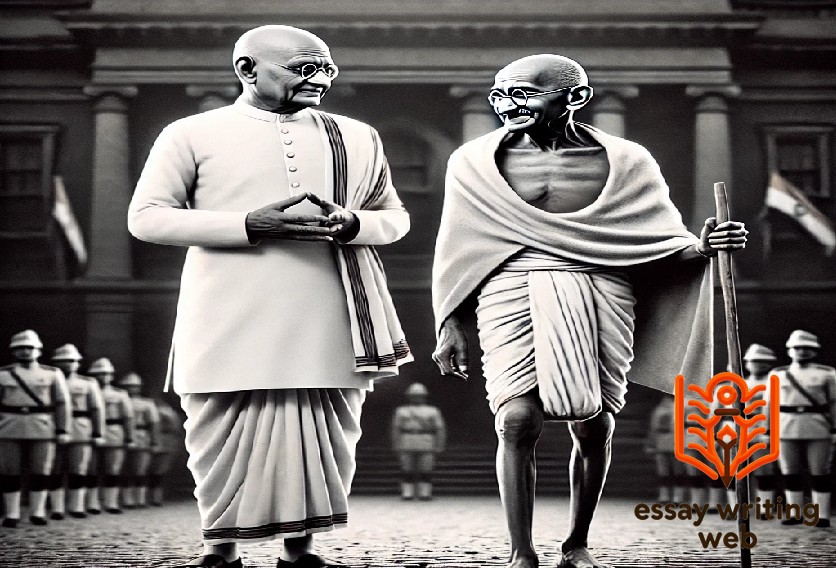
Vallabhbhai Patel, a central figure in India's struggle for independence, played a crucial role in shaping the nation's destiny. His contributions to the independence movement were marked by unwavering commitment, strategic brilliance, and a deep understanding of the socio-political landscape of India. Patel’s journey from a successful lawyer to one of the foremost leaders of the Indian National Congress exemplifies his dedication to the cause of India’s freedom.
Patel’s active involvement in the independence movement began in earnest after his encounter with Mahatma Gandhi. Inspired by Gandhi’s principles of nonviolence and civil disobedience, Patel transitioned from a prosperous barrister to a dedicated freedom fighter. His first major role in the movement was during the Kheda Satyagraha of 1918, where he led the farmers of Kheda district in Gujarat in their resistance against the British government's oppressive tax policies. Patel’s leadership during the satyagraha demonstrated his ability to mobilize people and effectively challenge British authority using peaceful means.
The Bardoli Satyagraha of 1928 further solidified Patel’s reputation as a leader of the masses. When the British imposed a heavy tax hike on the farmers of Bardoli, Patel organized a nonviolent campaign to resist the unjust demands. His strategic brilliance and ability to maintain discipline among the protestors led to the successful rollback of the tax. It was after this victory that Patel was given the title “Sardar,” meaning leader or chief, by the grateful farmers of Bardoli. This episode marked Patel as a key figure in the Indian independence movement, showcasing his determination and tactical acumen.
As the independence movement gained momentum, Patel’s role within the Indian National Congress grew increasingly significant. He was a staunch supporter of Gandhi’s methods and was instrumental in organizing and leading various campaigns against British rule. During the Salt Satyagraha of 1930, Patel was among the first leaders to be arrested by the British, reflecting his prominent role in the movement. Despite being imprisoned several times, Patel remained resolute in his commitment to the cause.
Patel’s leadership extended beyond organizing protests and satyagraha's; he was also deeply involved in the internal functioning of the Congress and played a vital role in maintaining unity within the party. His ability to mediate conflicts and bring together differing viewpoints was crucial in keeping the Congress cohesive during the challenging times of the independence struggle. Patel was known for his pragmatism and his focus on the practical aspects of the movement, ensuring that the Congress’s strategies were both effective and sustainable.
Patel’s most significant contributions to the independence movement was his role in the Quit India Movement of 1942. As a senior leader of the Congress, Patel was instrumental in organizing the nationwide protests demanding an end to British rule. His speeches during this period galvanized the masses, urging them to participate in the struggle with full force. Despite the brutal repression by the British, Patel’s leadership kept the movement alive, even as many leaders, including himself, were imprisoned.
As India approached independence, Patel’s role shifted to addressing the complex challenges of transitioning from colonial rule to self-governance. He was a key member of the Constituent Assembly, where his focus was on ensuring a smooth transfer of power and the establishment of a strong and united India. Patel’s efforts in negotiating with the British and his firm stance on issues of national interest were instrumental in securing India’s independence on August 15, 1947.
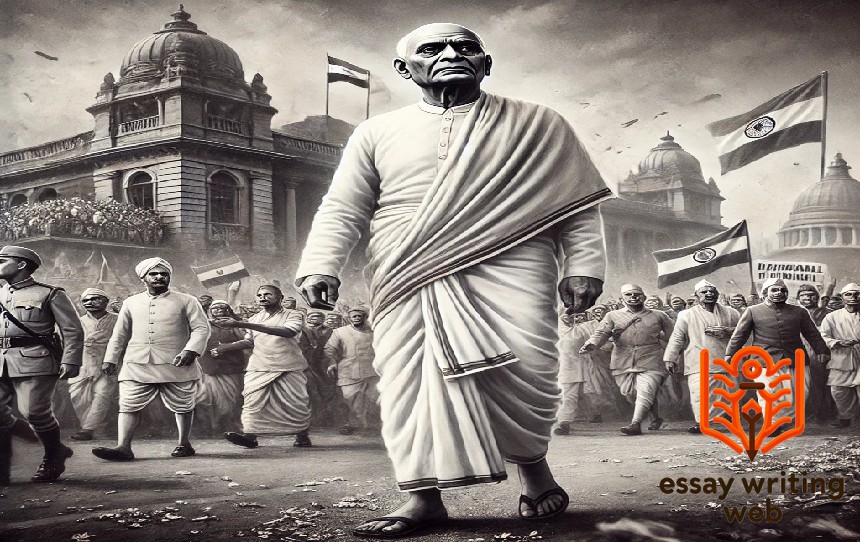
Sardar Vallabhbhai Patel, one of the most prominent leaders of the Indian independence movement, played a critical role in leading various protests and agitations against British rule. His leadership was marked by a combination of strategic brilliance, unwavering resolve, and a deep commitment to the principles of nonviolence and justice. Patel’s ability to inspire and mobilize the masses made him a key figure in the struggle for India’s freedom.
One of Patel’s earliest and most significant leadership roles was during the Kheda Satyagraha of 1918. This protest was a response to the British government's decision to impose taxes on the farmers of Kheda district in Gujarat, despite the region being severely affected by floods and famine. The farmers were unable to pay the taxes, and the British authorities refused to grant any relief. Patel, recognizing the injustice, took up the cause of the farmers. He led the movement with remarkable discipline and strategic planning. Patel encouraged the farmers to stand united in their refusal to pay the taxes, knowing well that their unity was their strength. The success of the Kheda Satyagraha was a significant victory against the British, and it established Patel as a leader who could effectively challenge colonial authority.
Another milestone in Patel’s leadership was the Bardoli Satyagraha of 1928, which became one of the most celebrated episodes in the history of India’s freedom struggle. The British government had imposed an unreasonable tax increase on the farmers of Bardoli, a taluka in Gujarat. Patel, understanding the severity of the situation, once again took the lead. He organized the farmers, educating them on their rights and the importance of nonviolent resistance. Patel’s leadership was instrumental in maintaining the discipline and morale of the protestors throughout the agitation. Despite the immense pressure and threats from the British authorities, Patel’s strategic use of non-cooperation and his ability to garner national and international support for the cause led to the British government eventually withdrawing the tax hike. The success of the Bardoli Satyagraha earned Patel the title “Sardar,” reflecting his role as a respected leader and protector of the people.
Patel’s leadership extended beyond regional movements to national campaigns against British rule. He was a key figure in the Salt Satyagraha of 1930, initiated by Mahatma Gandhi as part of the larger Civil Disobedience Movement. The movement was a direct challenge to the British monopoly on salt production and sales, a symbol of colonial exploitation. Patel’s role in organizing the salt satyagrahas in Gujarat was crucial. He was among the first leaders to be arrested by the British, underscoring his prominence and the threat he posed to the colonial government. Despite his imprisonment, Patel’s influence continued to be felt, as the movement spread across the country, igniting widespread civil disobedience against the British authorities.
In addition to these major movements, Patel also played a leading role in the Quit India Movement of 1942, which was the final mass protest against British rule before independence. As one of the senior leaders of the Indian National Congress, Patel was deeply involved in the planning and execution of the movement. His speeches and public addresses during this time were powerful, urging Indians to rise up and demand an immediate end to British rule. Patel’s ability to inspire courage and unity among the people was instrumental in sustaining the movement, even as the British responded with brutal repression.
Throughout his leadership in various protests and agitations, Patel remained committed to the principles of nonviolence and civil disobedience, as advocated by Mahatma Gandhi. His strategic thinking, coupled with his ability to connect with and mobilize the masses, made him an indispensable leader in the fight against British rule. Patel’s leadership was characterized by his pragmatism, his deep sense of justice, and his unwavering belief in the power of collective action.
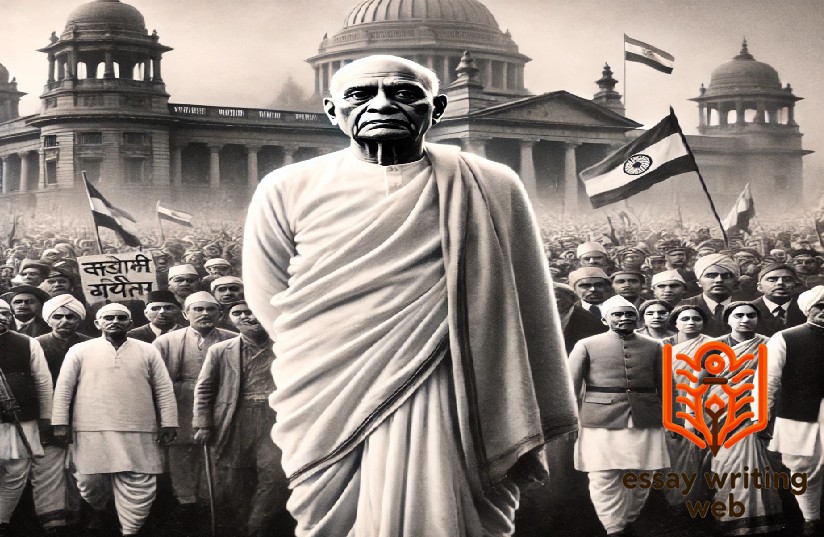
Vallabhbhai Patel, known as the "Iron Man of India," played a pivotal role in the shaping of independent India, particularly in his capacity as the first Deputy Prime Minister and Home Minister of the country. His tenure in these critical positions laid the foundation for a unified and stable India, as he undertook the enormous task of integrating the diverse and fragmented princely states into the Indian Union while also establishing a robust administrative framework.
When India gained independence in 1947, the nation was faced with the daunting challenge of integrating over 560 princely states, each with its own ruler and varying levels of autonomy. The British had given these states the option to join either India or Pakistan, or to remain independent. This posed a serious threat to the unity and integrity of the newly independent nation. Patel, as the Home Minister, took on the herculean task of ensuring that these states acceded to India. His approach was a blend of diplomacy, persuasion, and firmness. He negotiated with the rulers of the princely states, appealing to their sense of patriotism and offering them favorable terms for integration. However, when necessary, he did not hesitate to use force, as seen in the case of Hyderabad and Junagadh, where military intervention was required to ensure their accession to India.
Patel’s role in the integration of the princely states cannot be overstated. His efforts led to the successful unification of India, preventing the country from disintegrating into a collection of independent states. This achievement earned him the title of the “Iron Man,” as he demonstrated an unwavering commitment to the unity and integrity of the nation. Patel’s ability to bring together such a diverse array of states into one cohesive entity is one of the most significant accomplishments in the history of modern India.
In addition to his role in the integration of the princely states, Patel also played a crucial role in establishing the administrative structure of independent India. As the Home Minister, he was responsible for overseeing the creation of a new administrative framework that would govern the country. Patel was a strong advocate for a centralized administrative system, believing that a strong central government was essential for maintaining the unity and stability of the nation. He was instrumental in the formation of the Indian Administrative Service (IAS) and the Indian Police Service (IPS), which replaced the colonial-era became the backbone of India’s administrative machinery. Patel’s vision for a unified administrative structure ensured that the country could function effectively as a single entity, despite its vast diversity.
Patel’s role as the Deputy Prime Minister was equally significant. He was a close confidant of Prime Minister Jawaharlal Nehru, and the two leaders worked together to navigate the challenges of nation-building in the early years of independence. Patel’s pragmatic approach to governance complemented Nehru’s idealism, and together they laid the groundwork for a democratic and secular India. Patel’s contributions to the drafting of the Indian Constitution were also noteworthy, as he played a key role in shaping the provisions related to the federal structure of the government, the powers of the central and state governments, and the rights of citizens.
Patel’s tenure as Home Minister also saw the management of communal violence that erupted during the partition of India. The mass migration of people between India and Pakistan led to widespread violence, particularly in the Punjab region. Patel took swift and decisive action to restore order, deploying the army and police to control the violence and provide relief to the affected populations. His leadership during this turbulent period was marked by a commitment to maintaining law and order and protecting the lives of citizens.

Sardar Vallabhbhai Patel, often remembered as the "Iron Man of India," was not only a key leader in the Indian independence movement but also a visionary who played a pivotal role in shaping the future of the newly independent nation. His vision for India was rooted in the principles of unity, integrity, and strong governance, and it reflected his deep understanding of the complexities and challenges facing the country.
One of the central elements of Patel’s vision for India was the unification of the diverse and fragmented princely states into a single, cohesive nation. At the time of independence in 1947, India was a patchwork of over 560 princely states, each with its own ruler and varying degrees of autonomy. Patel foresaw the dangers of a fragmented India, where independent states could potentially weaken the nation’s unity and stability. His vision was to bring all these states under the umbrella of a united India, ensuring that the country remained strong and indivisible. Through a combination of diplomacy, persuasion, and, when necessary, the use of force, Patel successfully integrated these states into the Indian Union, laying the foundation for a united and stable nation.
Patel’s vision for India also emphasized the importance of a strong central government. He believed that a centralized authority was essential for maintaining order and unity in a country as diverse as India. His role in the creation of the Indian Administrative Service (IAS) and the Indian Police Service (IPS) was a reflection of this belief. Patel envisioned a professional and efficient civil service that would act as the backbone of the country’s administration, ensuring that the government could effectively implement its policies and maintain law and order across the nation. His efforts in establishing these institutions have had a lasting impact on India’s governance, and they continue to play a crucial role in the functioning of the country.
In addition to his focus on unity and strong governance, Patel’s vision for India was also deeply rooted in the principles of democracy and secularism. He believed that India’s strength lay in its diversity and that the country should be built on the foundations of democratic governance and respect for all religions and communities. Patel was committed to the idea of a secular India, where people of all faiths could live in harmony and equality. His contributions to the drafting of the Indian Constitution reflected this vision, as he played a key role in shaping the provisions related to the rights of citizens and the federal structure of the government.
Patel’s vision for India extended beyond political and administrative unity; he also understood the importance of economic self-sufficiency and social development. He was a strong advocate for the development of agriculture and industry, recognizing that a strong economy was essential for the nation’s progress. Patel believed in empowering the rural population, particularly the farmers, who formed the backbone of the Indian economy. His leadership during the Kheda and Bartoli Satyagraha’s, where he championed the rights of farmers against oppressive British policies, was a reflection of his commitment to improving the lives of the rural population.
Moreover, Patel’s vision for India was characterized by a pragmatic approach to nation-building. He was aware of the immense challenges that lay ahead for the newly independent nation and was determined to address them with practical solutions. His leadership was marked by a focus on results and a deep sense of responsibility towards the country’s future. Patel’s ability to balance idealism with pragmatism made him a key architect of modern India, and his vision continues to influence the country’s development to this day.
